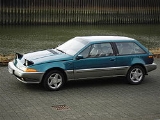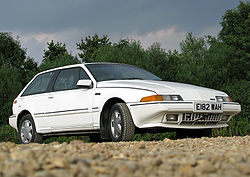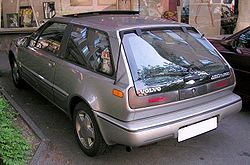
Volvo 480
Encyclopedia

Hatchback
A Hatchback is a car body style incorporating a shared passenger and cargo volume, with rearmost accessibility via a rear third or fifth door, typically a top-hinged liftgate—and features such as fold-down rear seats to enable flexibility within the shared passenger/cargo volume. As a two-box...
body, somewhere between liftback and estate
Station wagon
A station wagon is a body style variant of a sedan/saloon with its roof extended rearward over a shared passenger/cargo volume with access at the back via a third or fifth door , instead of a trunk lid...
in form, though marketed as a coupé
Coupé
A coupé or coupe is a closed car body style , the precise definition of which varies from manufacturer to manufacturer, and over time...
. It was the first front-wheel drive
Front-wheel drive
Front-wheel drive is a form of engine/transmission layout used in motor vehicles, where the engine drives the front wheels only. Most modern front-wheel drive vehicles feature a transverse engine, rather than the conventional longitudinal engine arrangement generally found in rear-wheel drive and...
car made by Volvo Cars
Volvo Cars
Volvo Car Corporation, or Volvo Personvagnar AB, is a Swedish automobile manufacturer founded in 1927, in Gothenburg, Sweden. It is owned by Zhejiang Geely Holding Group. Volvo was originally formed as a subsidiary company to the ball bearing maker SKF. When Volvo AB was introduced on the Swedish...
and the only production Volvo to feature pop-up headlamps.
Development
Press launch was on October 15, 1985, but the 480 was first put on show at GenevaGeneva
Geneva In the national languages of Switzerland the city is known as Genf , Ginevra and Genevra is the second-most-populous city in Switzerland and is the most populous city of Romandie, the French-speaking part of Switzerland...
in 1986, becoming available to the public in 1987. It was produced in Born, Netherlands, at the factory which built DAF
DAF Trucks
DAF Trucks NV is a Dutch truck manufacturing company and a division of PACCAR. Its headquarters and main plant are in Eindhoven. Cabs and axle assemblies are produced at its Westerlo plant in Belgium...
cars, including the DAF 66
DAF 66
The DAF 66 is a small family car produced by the Dutch company DAF from September 1972 to 1976. It was the successor of the DAF 55 and was itself superseded by the reworked Volvo 66...
-based Volvo 66
Volvo 66
The Volvo 66 was a Swedish automobile. It sprang directly from the DAF 66, which was originally styled by Michelotti. The compact car was introduced in August 1975, almost exactly a year after Volvo Cars bought DAF, and before production of the Volvo 300 series began.The Volvo 66 was known for its...
and later Volvo 300 Series
Volvo 300 series
The Volvo 300 series is a rear wheel drive automobile sold as both a hatchback and a conventional saloon from 1976-1991. It was launched in the Netherlands shortly after Volvo acquired a major stake in the passenger car division of DAF in 1973...
. The platform that was also used in the Volvo 440 and 460. It was originally planned for the North America
North America
North America is a continent wholly within the Northern Hemisphere and almost wholly within the Western Hemisphere. It is also considered a northern subcontinent of the Americas...
n market (as can be evidenced by its US-spec front and rear side markers, not used on European automobiles), but it was ultimately never sold in the U.S due to unfavourable currency
Currency
In economics, currency refers to a generally accepted medium of exchange. These are usually the coins and banknotes of a particular government, which comprise the physical aspects of a nation's money supply...
exchange rates. The 480 was the first Volvo of its sport back style since the P1800ES
Volvo P1800
-History:The project was started in 1957 because Volvo wanted a sports car, despite the fact that their previous attempt, the P1900, had been a disaster, with only 68 cars sold. The man behind the project was an engineering consultant to Volvo, Helmer Petterson, who in the 1940s was responsible for...
, and the last until the unveiling of the C30
Volvo C30
The Volvo C30 is a small family car produced by Volvo Cars. The C30 is a three-door, four-seat hatchback powered by straight-4 and straight-5 engines. The car is a hatchback version of the S40/V50/C70 range, and uses the same Ford C1 platform. It is being marketed as a premium hatchback or a...
. All of these models featured a distinctive frameless glass hatchback
Hatchback
A Hatchback is a car body style incorporating a shared passenger and cargo volume, with rearmost accessibility via a rear third or fifth door, typically a top-hinged liftgate—and features such as fold-down rear seats to enable flexibility within the shared passenger/cargo volume. As a two-box...
which has become something of a trademark for such Volvo coupés.
The concept was to design a sporty, luxury front-wheel drive car with advanced electronics. Unfortunately, the necessary technology was still in its infancy, and in the early days due to funding, the 480 suffered electrical problems. Revisions in the early 1990s saw improved reliability. Offsetting these problems, the car had excellent handling, due in no small part to its Lotus
Lotus Cars
Lotus Cars is a British manufacturer of sports and racing cars based at the former site of RAF Hethel, a World War II airfield in Norfolk. The company designs and builds race and production automobiles of light weight and fine handling characteristics...
-designed suspension, and a series of reliable Renault
Renault
Renault S.A. is a French automaker producing cars, vans, and in the past, autorail vehicles, trucks, tractors, vans and also buses/coaches. Its alliance with Nissan makes it the world's third largest automaker...
engines, tuned by Porsche
Porsche
Porsche Automobil Holding SE, usually shortened to Porsche SE a Societas Europaea or European Public Company, is a German based holding company with investments in the automotive industry....
.
Early cars suffered from electrical problems possibly down to an over ambitious "intelligent" central electronics module that many owners had replaced under warranty - some many times! Early cars also suffered from water leaks that probably were a contributory factor to the electrical problems. Later cars were much more reliable, though it is not uncommon to find a water filled spare wheel well, largely due to poor sealing around the trademark "frameless" glass hatch, and deterioration of the rear light cluster seals. The rear lights themselves often discolour and are notoriously brittle.
The 480 (particularly the 2.0 and TURBO) was a surprisingly good tow-car due to its relatively powerful engine, light weight and short rear overhang, however availability of towing equipment was limited, with few aftermarket manufacturers producing fixed tow brackets that unfortunately obstructed the low mounted rear numberplate. Volvo did supply a "detachable" tow bar for the 480 manufactured by "TOBO" a Swedish manufacturer now part of the BOSAL group. It was prohibitivly expensive over the "aftermarket" items, and still commands a high price should one become available second hand.
In 1988, a Turbo version was introduced, the Garrett AiResearch
Garrett AiResearch
Garrett AiResearch was a manufacturer of turboprop engines and turbochargers, and a pioneer in numerous aerospace technologies. It was previously known as Aircraft Tool and Supply Company, Garrett Supply Company, AiResearch Manufacturing Company, or simply AiResearch...
turbocharger
Turbocharger
A turbocharger, or turbo , from the Greek "τύρβη" is a centrifugal compressor powered by a turbine that is driven by an engine's exhaust gases. Its benefit lies with the compressor increasing the mass of air entering the engine , thereby resulting in greater performance...
increasing the power from 109 PS to 120 PS. Maximum torque was 175 newton metre instead of 140 newton metre for the naturally aspirated 1.7 L engine. In 1993 (UK), due to new legislation which meant that catalytic converter
Catalytic converter
A catalytic converter is a device used to convert toxic exhaust emissions from an internal combustion engine into non-toxic substances. Inside a catalytic converter, a catalyst stimulates a chemical reaction in which noxious byproducts of combustion are converted to less toxic substances by dint...
s had to be fitted to unleaded petrol engines, power dropped and so the 2.0 L engine was developed; it was rated at 110 PS and 165 newton metre. Standard 4 speed automatic transmission was also offered.
In 1992 the 480 was given new mirrors, and headrests for the back seats, along with subtle modifications to the trim and body-colour bumpers. The 2.0 naturally aspirated engine was also introduced in a bid to improve performance. Changes between the CEM (Central Electronic Module) are externally apparent with the introduction of a total closure system whereby the key can be held in the lock position to close the windows and (where fitted) sunroof. Earlier CEM modules feature a "passing" function for the wipers, whereby fully depressing the accelerator pedal will switch intermittent wipers to full.

Car Magazine
Car Magazine is a British automotive enthusiast magazine published monthly by Bauer Automotive. International editions are published by Bauer Automotive in Brazil, China, Greece, India, Mexico, the Middle East, Poland , Romania, Russia, South Africa , Spain, Thailand and Turkey...
, journalist
Journalist
A journalist collects and distributes news and other information. A journalist's work is referred to as journalism.A reporter is a type of journalist who researchs, writes, and reports on information to be presented in mass media, including print media , electronic media , and digital media A...
Richard Bremner made reference to its decent power and low weight combination. "This meant there was some danger of a sporty steer — pretty radical from a company
Company
A company is a form of business organization. It is an association or collection of individual real persons and/or other companies, who each provide some form of capital. This group has a common purpose or focus and an aim of gaining profits. This collection, group or association of persons can be...
that considered having fun at the wheel as acceptable as seducing a nun
Nun
A nun is a woman who has taken vows committing her to live a spiritual life. She may be an ascetic who voluntarily chooses to leave mainstream society and live her life in prayer and contemplation in a monastery or convent...
," he commented. "Good grief, a Volvo worth preserving. And there aren't many of them."
Prototypes for variants
The 480 factory also made several prototypes, including a 480 with an electric drivetrain, a supercharged version (G-LaderG-Lader
The G-Lader is a scroll-type supercharger used in various Volkswagen Passenger Cars models. Its purpose is to increase the motive power output from the internal combustion engine attainable with a given engine displacement. Since it is not enough to simply inject more fuel, as this produces too...
), a version with a 16-valve engine and a version with a turbocharged 2.0 L engine. However, none of these made it to production. A convertible
Convertible
A convertible is a type of automobile in which the roof can retract and fold away having windows which wind-down inside the doors, converting it from an enclosed to an open-air vehicle...
was announced to the press in summer
Summer
Summer is the warmest of the four temperate seasons, between spring and autumn. At the summer solstice, the days are longest and the nights are shortest, with day-length decreasing as the season progresses after the solstice...
1987 but wasn't seen in public until the 1990 Geneva Motor Show. It was planned to be launched at the beginning of 1991, but ultimately did not make production due to a supplier going bankrupt, concerns over roll-over safety protection and a too-long development process.

